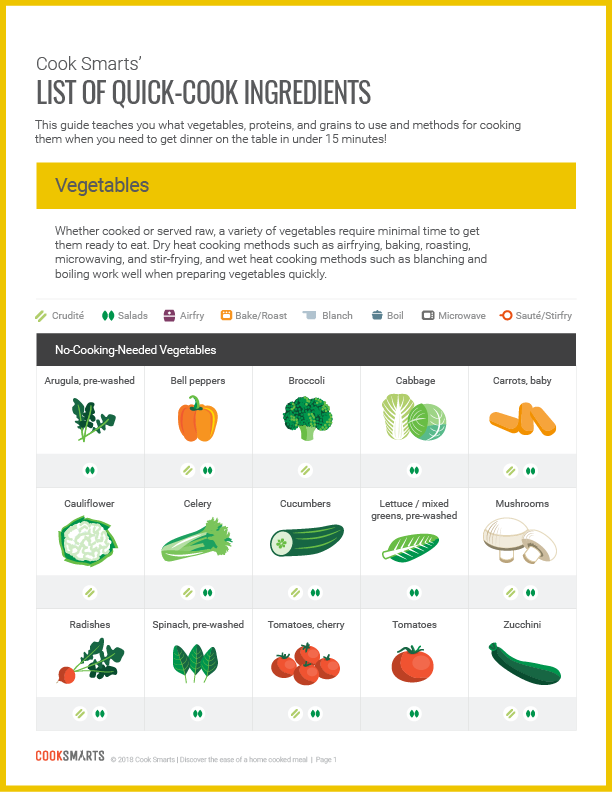Cook Smarts’ List of Quick-Cooking Ingredients
Prepare healthy homemade meals in 15 minutes or less with our list of quick-cooking ingredients, including vegetables, proteins and grains.
In the first part of our Quick-Cooking Series, we showed you a variety of vegetables that require zero to minimal prep. This week, we’re expanding our list of quick-cooking ingredients to show you which proteins, vegetables and grains can be cooked in 15 minutes or less.
If you can carve out 15 minutes to cook, you can absolutely prepare a healthy homemade meal. There’s no secret to it. It’s simply a matter of knowing which ingredients and cooking techniques to use — and that’s just what our handy infographic below shows you!
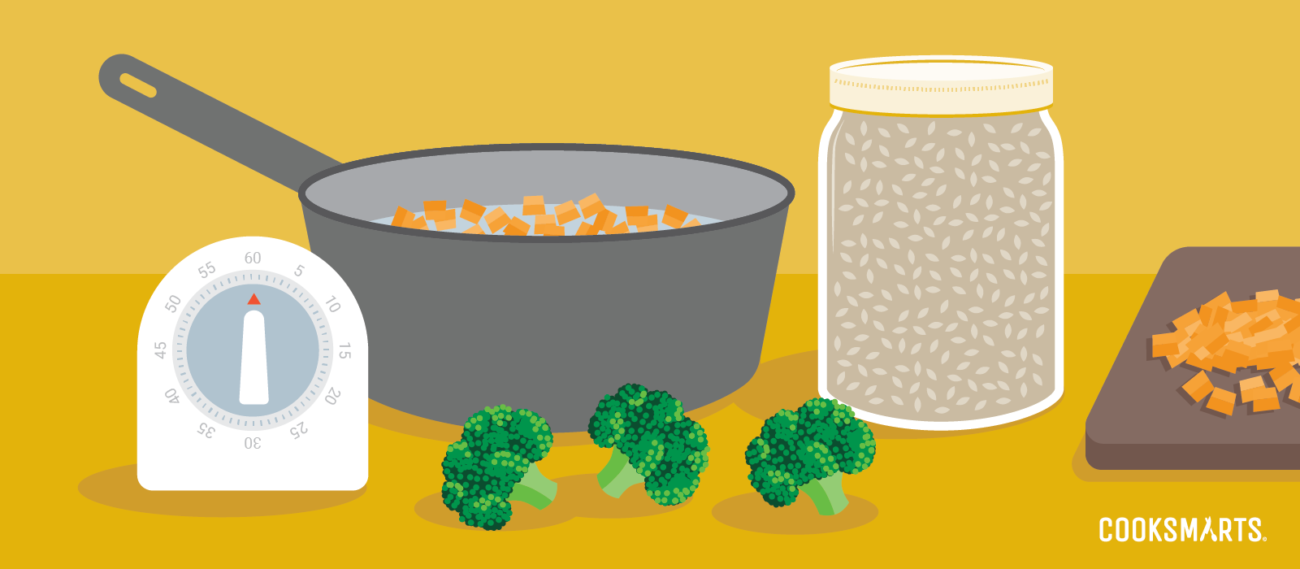
Guide to Quick-Cooking Ingredients
Discover which vegetables, proteins, and grains to cook with when you need to get dinner on the table in under 15 minutes.
Techniques for Quick Cooking
To cook an ingredient quickly you need to deliver the most amount of cooking power (heat) in the least amount of time. There are two main techniques of cooking – 1) dry-heat cooking and 2) wet-heat cooking.
Dry-heat cooking is when heat is transferred to food through circulation of hot air or direct contact with metal or fat. Methods of this cooking technique include airfrying, deep-frying, baking, roasting, grilling, sauteing, searing, stir-frying and microwaving.
Moist-heat cooking calls for liquids, such as water or steam, to transfer heat to the food. This can be done through blanching, boiling, simmering, braising, stewing, steaming and cooking en papillote.
When it comes to quick cooking, some cooking techniques work better than others, which is why we’ll be covering only several of these methods in this cooking lesson. Generally, dry-heat cooking techniques that use high temperatures are the way to go for proteins, but vegetables can be cooked quickly with a combination of dry and wet methods.
We’ll go through each of these methods more in a bit and provide you with some helpful resources to better understand some of these cooking techniques, but first, let’s talk about different ingredients you can cook quickly.
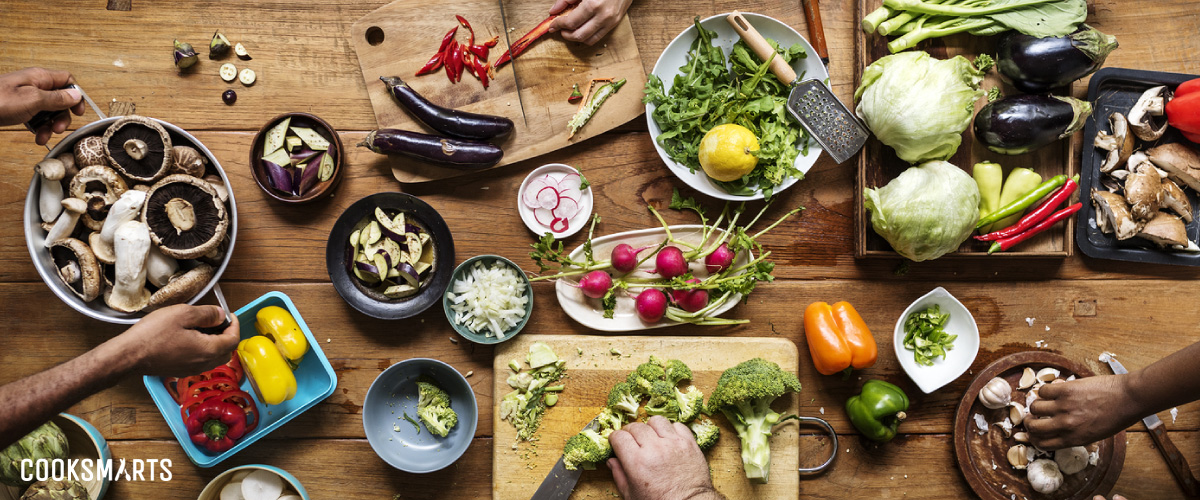
Vegetables that Cook Quickly
When it comes to vegetables, it isn’t always the cooking that takes the most time; it’s often the prep work. Slicing, dicing and chopping — it adds up! Hopefully, our List of Quick-Prep Veggies helped you on that front. Now, let’s shift to the cooking side of things.
Dry-heat cooking methods such as airfrying, baking, roasting, microwaving and stir-frying work well when cooking vegetables quickly as do certain wet heat cooking methods such as blanching and boiling. (We’ll dig more into the cooking methods later in this article.)
No-Cooking-Needed Vegetables
The good news about vegetables (besides their healthy qualities) is that many of them don’t require any cooking at all and can be served raw in a salad or in a crudite platter, including:
- Arugula, pre-washed
- Bell peppers
- Broccoli
- Cabbage
- Cabbage, napa
- Carrots, baby
- Cauliflower
- Celery
- Cucumbers
- Lettuce or mixed greens, pre-washed
- Mushrooms
- Radishes
- Spinach, pre-washed
- Tomatoes, cherry
- Tomatoes
- Zucchini
Fresh Vegetables that cook in <15 minutes
When you have a little more time to dedicate to cooking, the vegetables below require little to no prep work and cook in 15 minutes or less when you use our recommended cooking methods listed below.
- Asparagus – airfry, bake / roast, microwave, saute, stir-fry
- Bell peppers – microwave, saute, stir-fry
- Bok choy – saute, stir-fry
- Broccoli – blanch, microwave
- Cabbage – saute, stir-fry
- Cabbage, napa – saute, stir-fry
- Cauliflower – blanch, microwave
- Celery – saute, stir-fry
- Green beans – blanch, microwave, saute, stir-fry
- Kale – boil, saute, stir-fry
- Mushrooms – microwave, saute, stir-fry
- Okra – saute, stir-fry
- Potatoes – boil
- Snow peas – saute, stir-fry
- Spinach, pre-washed – saute, stir-fry
- Sugar snap peas – saute, stir-fry
- Swiss chard – saute, stir-fry
- Tomatoes, cherry – saute, stir-fry
- Tomatoes – saute, stir-fry
- Zucchini – airfry, microwave, saute, stir-fry
Bonus tip: If you want to speed up the cooking process even more, try cutting the vegetables into smaller pieces which will cook faster than larger ones.
Frozen Vegetables
When you’re really crunched for time, the frozen vegetables below come pre-prepped and ready to cook straight from the freezer:
- Broccoli
- Butternut squash
- Carrots
- Cauliflower
- Corn
- Green beans
- Mushrooms
- Okra
- Peas
- Vegetable medleys
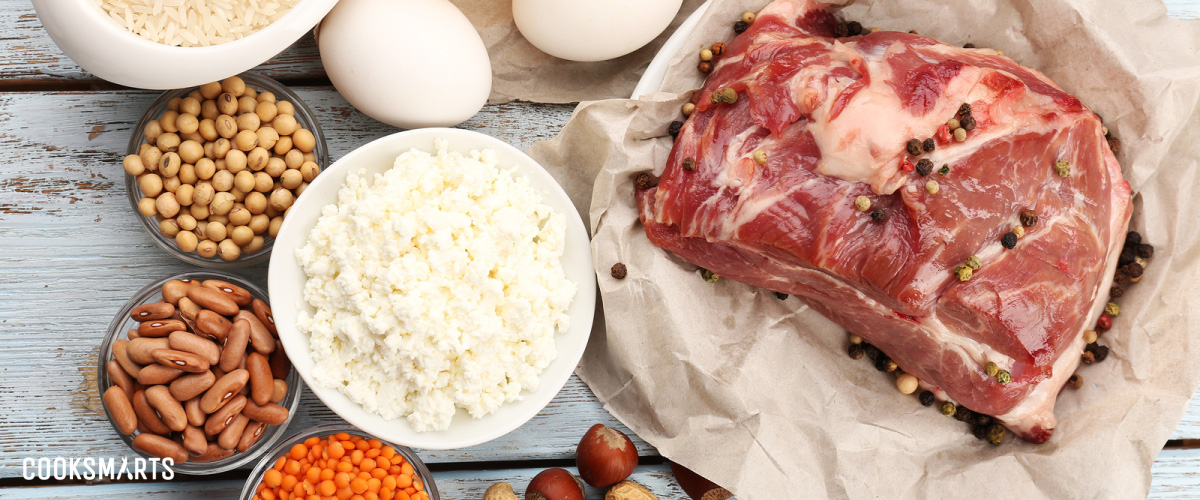
Proteins that Cook Quickly
Next on our list are quick-cook proteins. Generally, the smaller or thinner-cut the piece of meat, poultry or fish, the faster it cooks. Similarly, cuts that are more tender — think sirloin, pork loin chops or chicken tenderloins — typically cook faster than tougher cuts that require more time to become tender like chuck steaks, bottom round or pork shoulder.
Dry-heat cooking methods such as airfrying, baking, roasting, grilling, pan-searing, sauteing and stir-frying that use high temperatures are ideal when cooking proteins because they minimize moisture loss while also preventing mushiness.
Our list of proteins below includes tender cuts of pork and beef, lean fish fillets, small seafoods and vegetarian proteins that you can cook in 15 minutes or less using one of the dry-heat methods we mentioned above. (For more details on which method works best with each ingredient, print out the free infographic here.)
Seafood
For the fastest cooking seafood (10 minutes or less), look for lean white-fleshed filets and small proteins such as:
- Scallops
- Shrimp
- Cod
- Tilapia
- Sole
- Tuna steaks
When you have a few more minutes to spare, you can cook meatier fish such as:
- Salmon
- Swordfish
Meats
For land-roaming proteins that can be cooked in under 10 minutes, look for tender, thin-cut, pre-cooked or pre-cut options such as:
- Thin-cut steaks (flank, hanger, skirt)
- Pork loin chops, thin cut
- Sausage, pre-cooked
- Chicken tenders
Or, if you have a little more time, try these proteins:
- Steaks (NY strip)
- Pork loin chops
- Chicken breasts, sliced, boneless and skinless
Vegetarian Proteins
While meat proteins may be the most obvious source of protein, there are delicious vegetarian proteins that cook quickly too, including:
- Tofu
- Tempeh
- Seitan
- Canned beans
- Eggs
*Note: For eggs, scrambling (sauteing) and frying (pan-searing) are the quickest methods to cook eggs, although you can soft- or medium-boil eggs (boiling) or even poach eggs (simmering) under 10 minutes as well.
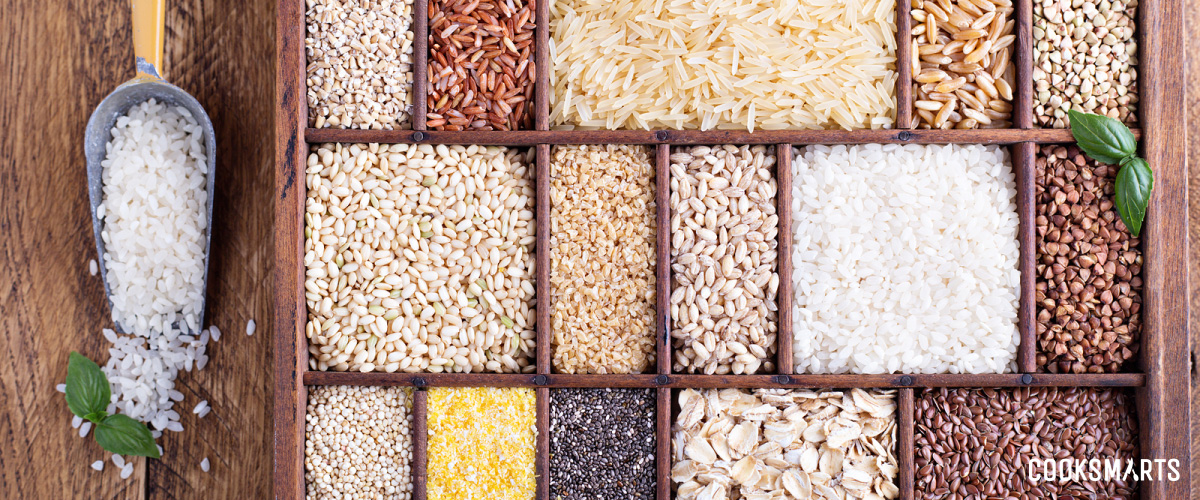
Grains that Cook Quickly
Grains like couscous and bulgur (to name a few!) only need a pot of boiling water to cook and are ready in minutes. Plus, they’re inexpensive and a great way to add iron, protein and fiber to your diet. For the grains below, simply combine water and grains (using the ratio provided in the infographic), bring to a boil, and then simmer for the suggested time.
- Couscous
- Bulgur
- Oats, rolled
- Buckwheat groats (kasha)
- White rice
- Quinoa
Dry-Heat Cooking Techniques
Airfrying is a relatively new cooking technique that uses an airfryer to circulate hot air to “fry” food without using large amounts of oil. It’s similar to a convection oven, but in a much smaller space. We talk more about airfrying and how to airfry vegetables here:
How to Fry Vegetables in an Air Fryer
See how we use our air fryer to create crispy-on-the-outside, tender-on-the-inside vegetables without the fat! Air fry everything from broccoli,… Read more.
Baking and roasting both use the oven and brown the exterior of foods, however, roasting usually involves cooking foods with a solid structure (veggies and meats), while baking usually involves foods that become solid as they cook (muffins and cakes). See the roasting technique in action below, but remember to use our recommended veggies for roasting in under 15 minutes’ time.
How to Roast Veggies
We use super high temperatures to roast veggies quickly, making it perfect for any weeknight dinner.
This is one of the best high-heat cooking methods because the direct exposure to the flame quickly draws out an ingredient’s natural sugars which then caramelize to form a crispy exterior while keeping a juicy interior. We show you how to grill both vegetables and proteins in these videos below:
How to Grill Vegetables
Give vegetables a different flavor profile when you learn how to grill them with this video.
How to Grill Proteins on High Heat
Learn how to grill proteins (like steak!) at high heat with our cooking video.
This method involves cooking the surface of an ingredient in a pan over high heat until a crust forms through the process of caramelization and the Maillard reaction.
Typically after searing, you would transfer everything into the oven to finish cooking through roasting, like how we show in the video below. However, by lowering the heat after the initial sear, you can cook the ingredient all the way through using the same pan and the stovetop. This works especially well for thinner cuts of meat, and covering the pan will help meats cook more evenly and thoroughly.
How to Sear and Roast Meat
Searing meats gives them a golden-caramelized color and then finishing it with a roast in the oven allows meat to cook evenly - see how to do it here.
Sauteing involves cooking an ingredient using a small amount of fat in a shallow pan over high heat. This technique works well when you want to quickly cook an ingredient all the way through or when you want to soften ingredients like onions to build a flavorful base. Watch how we do it here:
How to Saute Vegetables
Sauteing is a quick way to prepare and cook a wide variety of vegetables.
Stir-frying is a Chinese cooking technique that uses high heat and a small amount of oil in a wok, which is a round-bottomed pan with tall sides. A wok is a great tool when cooking ingredients that require different cooking temperatures or when you need to moderate temperatures quickly because the bottom of the pan stays hotter than the sides. So if you need to reduce heat on certain ingredients, you can push them up the sides. Another benefit of using a wok is that it allows you to quickly stir or toss ingredients without worry about them spilling over the sides.
To get you started with stir-frying, check out the video below. We also have a complete cooking lesson on how to stir-fry; it features an infographic that contains many stir-fry combos, so you will never have to waste time thinking of what to stir-fry!
How to Make a Stir-Fry
Stir-frying is a great way to bring together just about any vegetable and protein combination in a fast and tasty way.
Stir-Frying 101: A Guide to Quick & Healthy Meals
The stir-fry guide that's been featured on the front page of Reddit and shared thousands of times. Turn any ingredient… Read more.
Wet Cooking Techniques
- Blanching is the process of boiling an ingredient for a short amount of time — a minute or two — and then placing it in ice water to preserve its texture and color.
- Boiling is the process of using water at its highest temperature (212 degrees fahrenheit) or other liquids to cook an ingredient.
Now that you have a variety of quick-cooking ingredients to call on and an idea of the best cooking methods to use, we hope you’re starting to feel more confident that you can cook without committing a whole bunch of time. Be sure to download the free PDF of this infographic so you can reference these ingredients any time you need a healthy meal on the table, quick:
As with all of our resources, this list is not meant to be limiting; it’s simply meant to provide you with a baseline of information that’ll help you cook smarter, eat healthier and build your confidence in the kitchen!
What are some ways you like to save time cooking? Any ingredients you want to add to the list? Let us know in the comments!
We’re here to help you live your best life in the kitchen and provide delicious memories for you and your family. Join our cooking community by signing up for our newsletter below, and we’ll send you great cooking tips and resources that will help you raise your kitchen IQ and cook with confidence.

